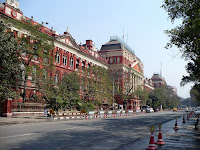Kolkata(also known as Calcutta), is the third biggest city in the country of India. It is located on the eastern bank of the River Hoogly, and branch of the River Ganges. It has a population of almost 16 million, the thirteenth largest city in the world. It covers an area of 185 square kilometers. The central business district is located on the banks of the river, and is well connected, being within ten minutes of both Howrah station and Sealdah station, two of India's most major train stations. As one traverses away from the calm, clean green city centre, the city seems to transform itself, turning noisier, busier, with less Victorian formality and more liveliness of the modern Calcutta. Modern Calcutta is unique from the perspective that, although Western Culture does show its appearances and growing influence, the current generation is still reluctant to let go of the rustic, active culture of the past. Traditional spicy Indian street foods can be found on every street corner, sweet shops full of Bengali delicacies, boutiques with modern western fashions and traditional saris alike. Calcutta is really a city caught in the middle of the old and the new. Just travelling around the city is an experience on its own; Calcutta has many unique forms of transport. Apart from the usual cars, taxis buses and Metro, numerous other forms of transport exist, including pedal-powered and hand pulled rickshaws, three-wheeled open vehicles commonly called autos, and the tram, an especially special form of transport dating from the British period. This is something like a small train running through the city roads, with tracks but no stations, often dropping people off on the streets. The land on which the city of Calcutta was made was once a part of the Sundarbans(literally 'Beautiful Forests'), the mangrove forests of the massive delta on the Rivers Ganges, Meghna and Bramhaputra. Evidence of its watery past can still be seen in the suburbs of Kolkata. Just outside the fringe of buildings starts the Wetlands, with extensive fish and amphibious wildlife, as well as a range of rare plants, insects and birds. Ponds, almost as a reminder of what the city used to be, can be found extensively in the city suburbs, often providing respite from the heat and a summertime swimming pool for locals. However, along with the exciting life of the middle and upper classes, there are also exists a large proportion of people living in intense poverty. One is never allowed to forget the other half of the world, the one of hunger and stress, not knowing when your next meal will come, not knowing if you can afford an education for your children tomorrow, not having a roof over your head. As one walks down the road, one can see the poor everywhere, pulling the rich on rickshaws, small children begging on the street, men and women sorting through trash desperately trying to glean materials which they can sell, making all manner of street food for sale in an attempt to earn a few rupees to buy their next meal with. You'll always be faced with the sight of poverty. There is no escape from it, it's an in-your-face type of experience. Kolkata is one of the most interesting cities I've ever seen. Within just a few metres of each other one can find the rich and the poor, the Eastern and the Western, the happy and the sad. Everything there is to experience in the world, can be experienced here. |
Wednesday, 19 October 2011
Kolkata, Our City.
Subscribe to:
Post Comments (Atom)




No comments:
Post a Comment